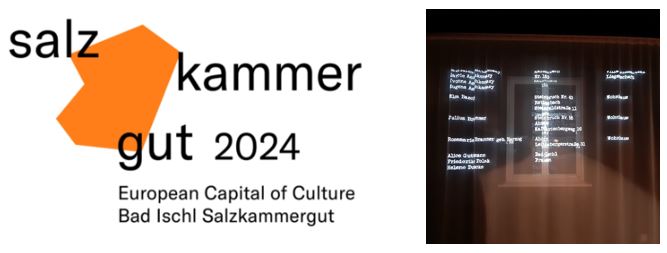Centre for Interdisciplinary Holocaust and Genocide Studies
Centre for Interdisciplinary Holocaust and Genocide Studies
Holocaust Narratives in the European Capital of Culture 2024
Chloe Paver, Associate Professor of German, University of Exeter

Whenever the EU’s Capital of Culture designation is awarded to a German or Austrian city, the organizers reflect on the role of the locality during the Nazi era. That, at least, is the hypothesis in one strand of my current research. Certainly, the more traditionally picturesque venues, such as Linz and Weimar, see it as their duty not to hide behind their heritage facades.
The 2024 Capital of Culture was awarded to a picturesque region of Austria, the Salzkammergut. Rather like the UK’s Lake District, the Salzkammergut combines lakes, mountains, and a mining past – the ‘salt’ in its name. The spa town of Bad Ischl led a consortium of towns and villages to win the bid.
As anticipated, a number of events in the year-long programme for ‘Salzkammergut 2024’ relate to the Nazi era. Most of these involve stolen art and property, including an exhibition at Linz’s LENTOS museum, ‘Die Reise der Bilder’ (‘The Journey of the Paintings’), which has just finished its run. Exhibitions about art stolen from Jewish owners in the 1930s and 1940s run the risk of allowing the art to be enjoyed on its own terms. Once hung on the walls, the works speak directly to the viewer, bypassing the pain that attended their theft and the exile or murder that followed it. An added challenge for the Salzkammergut is that this strand of its art history is interwoven with others. For instance, thousands of artworks – only a small proportion of which were stolen from Jewish owners – were hidden in mine shafts in the 1940s, to protect them from Allied bombing. The George Clooney film The Monuments Men has popularized this story. ‘Die Reise der Bilder’managed to tell this complex history while nevertheless keeping the suffering of Holocaust victims at the forefront. The exhibition design combined artwork and text in such a way that the narrative took precedent over aesthetic enjoyment. The exhibition also shone a light on the continued efforts of provenance researchers to return stolen items to the heirs of rightful owners.
In mounting this exhibition for Salzkammergut 2024, the big city of Linz was lending support to the small towns and villages of the Salzkammergut, since no amount of EU money would make it possible for them to put on a major art exhibition. Nonetheless, the spa town of Bad Ischl took the opportunity of ECoC funding to redesign its Stadtmuseum and, in doing so, to replace an old-fashioned Heimatmuseum, with its collections of vernacular craft objects, with a state-of-the-art local history museum. The new exhibition, housed in a former hotel, puts the Holocaust at its centre while still entertaining visitors with stories of Bad Ischl’s legendary tourist hospitality. The section covering the 1920s and 1930s, which could have been told as a general history of political upheaval, is focused through the lens of Jewish experience. In the 19th and 20th century, Austrian Jews took part in the annual migration of the prosperous middle classes from the city to the countryside, known as the Sommerfrische, and many stayed in hotels or villas at Bad Ischl. The displays stress the gradual loss of security and opportunity under conditions of anti-semitism well before the Anschluss of 1938 and the increasingly harsh anti-Jewish measures taken after the Anschluss. These began with prohibitions on using the facilities of the spa town and ended with exile or deportation. Further on in the exhibition, to illustrate local bureaucrats’ involvement in ‘Aryanization’ (the state-organized programme of theft from Jews), an office is mocked up and the sound of a typewriter is heard as names and addresses of Jewish property owners appear to be typed onto a projection screen opposite, producing a variation on the familiar format of a roll call of names of the murdered.
The sequencing of displays is key to creating the message of a history exhibition, and here the fate of Jewish victims is prioritized by both preceding and following a small section on Nazi culture and society. The only criticism that might be made is that the museum displays objects with swastikas in two vertical vitrines. These flank a deckchair with the Nazi insignia printed on it, and the three-part display faces the visitor immediately opposite a door opening. Most memorial museums favour table vitrines for such objects, since these reduce visibility and invite an attitude of scholarly study.
While Bad Ischl’s redesigned Stadtmuseum – and similar, temporary events put on as part of Salzkammergut 2024 – can be celebrated as a good-news story, the effectiveness of such initiatives is open to question. If the Capital of Culture programme acts as a progressive and liberalizing force, this does not alter the fact that the Salzkammergut gives a significant share of its vote to the hard-right populist party, the FPÖ. Austria is shortly to elect a new government, and the FPÖ may well emerge as the largest party. Of course, it is important not to make shallow comparisons between the 1930s and the 2020s, nor indeed between the groups discriminated against then and now. Still, it would clearly also be foolish to assume that documenting the fates of Holocaust victims can immunize citizens against exclusionary rhetoric and policies in the current day. In 2025, the Capital of Culture will move to the German city of Chemnitz, in Saxony, where the hard-right AfD party was only narrowly beaten by the centre-right CDU in recent regional elections. It will be interesting to observe whether the same dynamics play out in Chemnitz. Possibly, the city’s GDR past and its proximity to the Czech Republic, in the heart of today’s EU, will deprioritize Holocaust history; the electoral successes of the AfD may reprioritize it.
Published September 2024